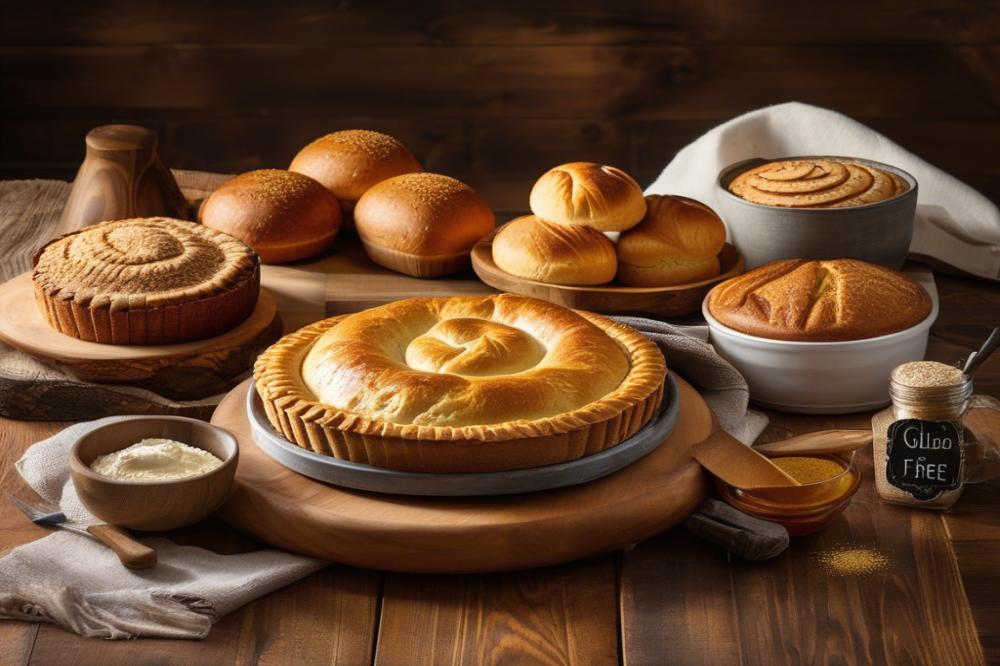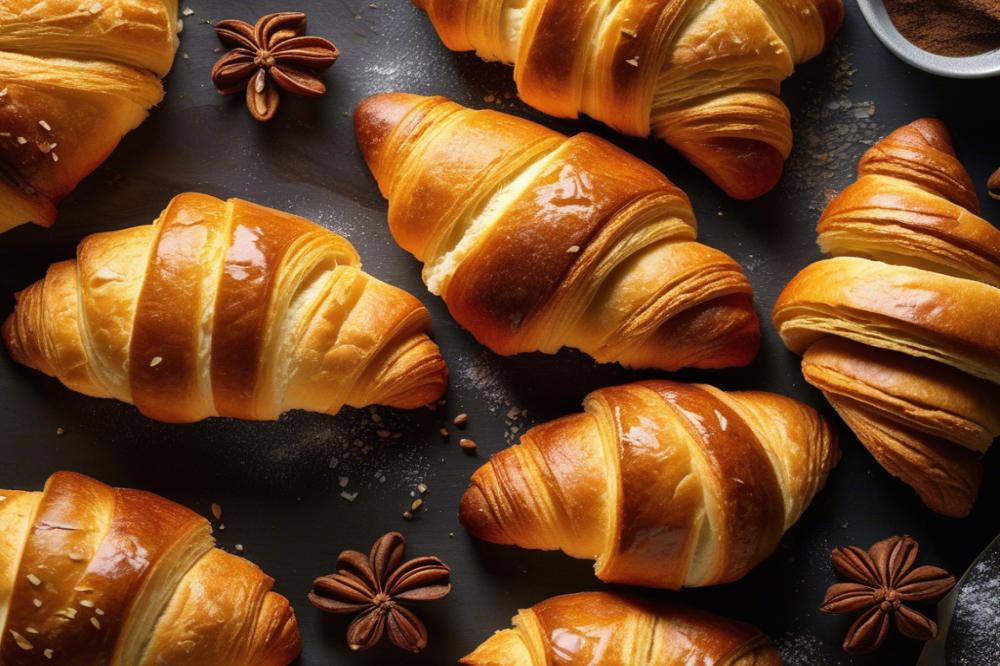Options
In recent years, gluten-free diets have gained immense popularity. For many individuals, a gluten-free lifestyle brings relief from discomfort and health issues. Gluten, a protein found in wheat, barley, and rye, can cause serious problems for people with celiac disease or gluten sensitivity. This has sparked a crucial need for diverse alternatives.
Finding suitable products is vital for those who cannot consume gluten. The market has responded with a variety of foods that cater to these dietary restrictions. Shoppers today are no longer limited to bland options. Instead, they can find flavorful and satisfying items that fit their needs quite well. Among these alternatives, gluten-free breads, pies, and pastries stand out, transforming meals and snacks.
Many people miss the comforting taste and texture of traditional baked goods. However, the advancement in gluten-free baking has led to remarkable changes. Innovative recipes now use ingredients like almond flour and coconut flour to mimic the qualities of wheat-based products. This means those adhering to gluten-free diets can enjoy fresh breads, savory pies, and delectable pastries.
Ultimately, the world of gluten-free options is diverse and exciting. These alternatives not only fulfill dietary requirements but also enhance culinary experiences. As we explore this topic further, we will look closely at gluten-free breads, pies, and pastries. They represent a significant part of the gluten-free landscape. Discovering and enjoying these treats can bring joy to many tables.
To learn more about delicious gluten-free recipes, check out this amazing resource. You’ll find plenty of ideas to inspire your meals. Additionally, find more information on gluten-free living by visiting this helpful site.
Understanding Gluten-Free Options

What Gluten-Free Means
Gluten-free refers to food items that do not contain gluten. Gluten is a protein found in wheat, barley, and rye. For some individuals, especially those with celiac disease, consuming gluten can lead to serious health issues. Symptoms may include digestive discomfort and other physical ailments. Awareness of gluten-free diets has increased significantly over recent years, making it easier for those who need to follow this lifestyle.
Common Gluten-Free Ingredients
Several ingredients are naturally gluten-free. Rice, corn, and potatoes are popular choices. Many people enjoy quinoa, which has gained popularity in recent diets. Other alternatives include beans, lentils, and various nuts. For baked goods, gluten-free flours like almond or coconut flour can be used. These choices allow more variety in meals while accommodating specific dietary needs.
Nutritional Considerations for Gluten-Free Options
When following a gluten-free diet, nutrition is an important factor to consider. Some gluten-free products might lack essential nutrients. Often, refined gluten-free foods can be low in fiber and protein. Those relying on gluten-free options should focus on whole foods. Fresh fruits, vegetables, and lean proteins provide necessary vitamins and minerals. Balancing a diet requires paying attention to what you eat. This ensures that nutritional needs are met without gluten-related health concerns. Individuals should consider supplements or fortified foods if they find themselves lacking nutrients.
Best Gluten-Free Breads

Types of gluten-free bread available
Various types of gluten-free bread can cater to different tastes and preferences. Some popular options include rice bread, almond flour bread, and chickpea bread. Many people enjoy sourdough made from gluten-free grains. Other varieties might incorporate seeds and nuts for added flavor and texture. Flatbreads also come in gluten-free versions and are perfect for wraps or dips. Specialty retailers often offer inventive blends, increasing accessibility to diverse tastes.
Ingredients that make great gluten-free bread
The right ingredients play a critical role in making gluten-free bread enjoyable. Common bases include brown rice flour, sorghum flour, and tapioca starch. Many recipes include xanthan gum or psyllium husk to help mimic the elasticity of traditional bread. Using eggs can improve the structure and moisture in the final product. Additionally, incorporating ingredients like applesauce or yogurt can enhance flavor and texture. Remember that experimenting with different combinations can lead to interesting results.
Tips for baking gluten-free bread at home
Baking gluten-free bread requires some adjustments. First, always measure your ingredients accurately. Slight variations can affect the outcome significantly. Another suggestion is to let the batter rest before baking. This allows the flours to absorb moisture properly. Use a good-quality pan to promote even baking, making sure to grease it adequately. When done, let the bread cool completely before slicing. Lastly, don’t hesitate to try different baking times. Every oven operates differently, so check for doneness frequently.
Delicious Gluten-Free Pies
Overview of Gluten-Free Pie Crust Options
Finding suitable crusts can be challenging, but many options exist. Almond flour, coconut flour, and rice flour are popular choices. Some recipes blend these flours for a perfect texture. Ready-made crusts also provide convenience. Brands like Bob’s Red Mill and Kinnikinnick offer pre-made options. Ensure you check for certification to avoid cross-contamination. Many crusts have the right balance of crunch and tenderness, making them tasty alternatives.
Popular Gluten-Free Pie Fillings
Variety in fillings can make any pie delightful. Classic flavors like apple and cherry remain favorites for all occasions. Pumpkin pie, with its rich and spiced filling, is particularly popular during holidays. Chocolate silk pie offers a decadent dessert choice. Fresh berries, whether strawberries or blueberries, add a fruity burst. For something different, consider pecan or even custard fillings. Each filling brings its own unique flavor profile, and creativity can result in surprisingly delicious combinations.
Recommendations for Store-Bought Gluten-Free Pies
Store-bought options can save time while still delivering flavor. Whole Foods carries a range of gluten-free pies perfect for busy days. They offer seasonal choices, like pumpkin and pecan, during the holidays. Trader Joe’s is another go-to for delightful selections. Their fruit pies receive rave reviews for taste. If searching online, brands like Against the Grain Gourmet have excellent options too. Always read labels. Quality varies, so look for gluten-free certifications to avoid surprises.
Irresistible Gluten-Free Pastries
Types of Gluten-Free Pastries
Pastries can be delightful treats, and they come in many forms. Common types include tarts, cookies, and pies. Each pastry can be made with gluten-free flour, allowing those with dietary restrictions to enjoy these delicious options. Savory pastries like quiches also fit into this category. Empanadas and turnovers filled with vegetables or meats offer a tasty twist. Each variety brings its own appeal and can be gluten-free.
Ingredients and Techniques for Making Gluten-Free Pastries
Making gluten-free pastries requires different ingredients than traditional options. Almond flour, coconut flour, and rice flour are popular choices. These flours can be combined to create the right texture. Binding agents, like xanthan gum or psyllium husk, help mimic the elasticity that gluten usually provides. These ingredients play a critical role in achieving a satisfying crumb.
Techniques vary but are essential for the best results. Cold butter should be used to create flaky layers. Mixing the ingredients carefully will prevent overworking the dough, preserving its delicate nature. Refrigerating the dough before baking can improve texture. This step can make gluten-free pastries rise better and hold their shape.
Ideas for Flavored Gluten-Free Pastry Recipes
Flavor can make or break a pastry. Consider adding fresh fruits like blueberries or strawberries for a sweet touch. Citrus zest brings a refreshing taste to tarts and muffins alike. Chocolate chips can create decadence in cookies, while spices such as cinnamon and nutmeg can enhance pies.
For a savory option, think about incorporating herbs and cheeses into your dough. A rosemary and goat cheese pastry can be both impressive and tasty. Spinach and feta, wrapped in a gluten-free crust, also provides a comforting meal idea. Various flavor combos allow for endless creativity in the kitchen.
Next time you want a treat, consider gluten-free pastries. They can cater to dietary needs while still delivering on flavor and texture. So, gather your ingredients and start experimenting!
Exploring Alternative Flours
Overview of Gluten-Free Flours
Gluten-free flours come from a variety of sources. You might encounter flours made from rice, almonds, or even coconut. Each type has its own flavor and texture. For instance, almond flour adds a slight nuttiness, while coconut flour is more subtle. Many find that using these flours can open up a whole new world of baking. However, it can also be overwhelming to choose among them. Knowing the characteristics of each flour helps in making the right decisions for your recipes.
How to Choose the Right Flour for Breads, Pies, and Pastries
Selecting the right flour is crucial, especially when making breads, pies, or pastries. Some flours are better suited for specific baking tasks. For example, rice flour works well in bread-making but may not provide the desired crispiness in pastry crusts. Consider what you are aiming to create. Moisture content and density vary among different flours, so it’s essential to assess these factors. Don’t forget about your personal taste preferences. Trying different options can lead to discovering the perfect match for your dish.
Blending Gluten-Free Flours for Optimal Results
Blending various gluten-free flours can enhance texture and flavor. Each flour brings unique qualities to the mix. Many bakers enjoy a combination of almond flour and coconut flour, which can create a pleasant softness. Experimenting with a mix of flours may improve the final outcome of your baked goods. Start with small batches to test how the flavors meld together. Over time, you will learn which combinations work best for you. Always remember that practice leads to improvements in your baking skills.
Wrapping Up Gluten-Free Goodness
Gluten-free options for breads, pies, and pastries have come a long way. It’s incredible how many choices are now available for those who need to avoid gluten. From fluffy breads made with almond flour to flaky pie crusts crafted from rice flour, there’s a world of flavors waiting to be explored. Even pastries like brownies and muffins have gluten-free versions that deliver on taste.
Don’t be intimidated by gluten-free baking. It can be a fun and rewarding experience. Many ingredients work beautifully together to create satisfying textures and flavors. Trying out different recipes is an exciting way to discover what you like best. Experimenting in the kitchen can lead to some surprising results! Whether you’re a seasoned baker or a beginner, it’s all about creativity.
Enjoying gluten-free treats does not mean sacrificing flavor or texture. With the right ingredients and a bit of practice, you can savor baked goods that are just as delightful as traditional ones. Some may even argue that these alternatives offer an entirely new taste experience. So, take the plunge and whip up something special!
In summary, embracing these gluten-free options can open doors to delicious possibilities. You owe it to yourself to give it a try. With a little adventure and patience, you might find your new favorite recipes among the gluten-free selections. Don’t forget to check out #anchor_text_3# and #anchor_text_4# for even more inspiration on your gluten-free journey. Happy baking!



